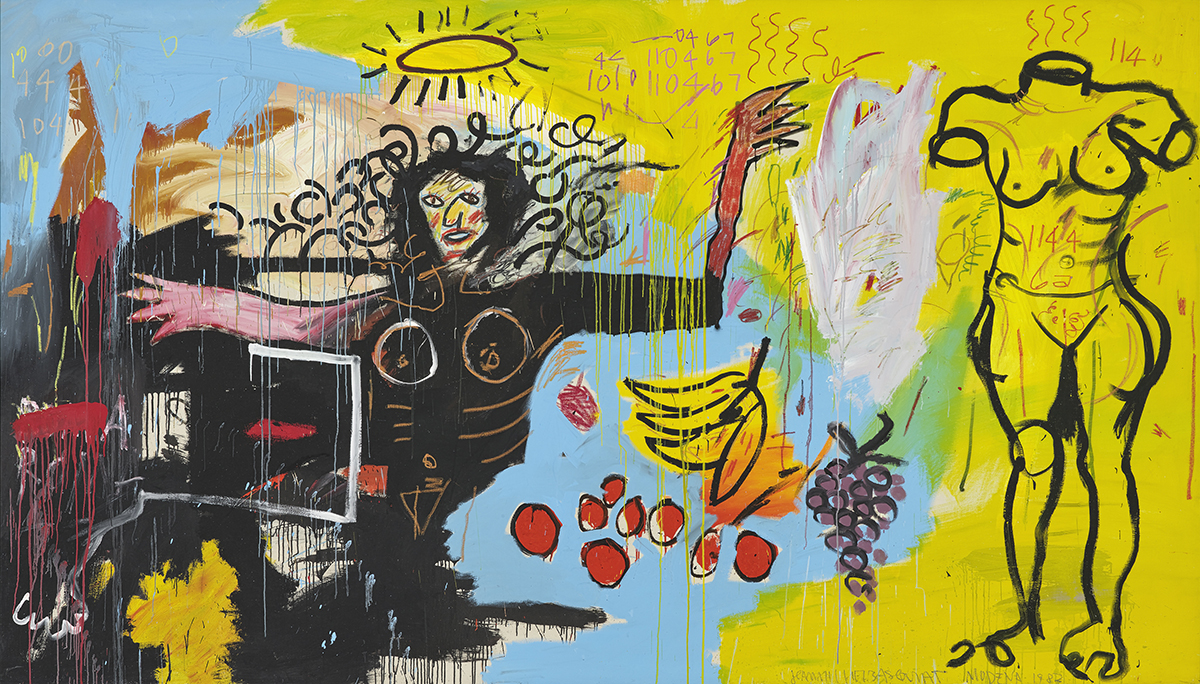
Jean-Michel Basquiat, Untitled (Devil), 1982. Private Collection; © 2023 Phillips Auctioneers LLC, all rights reserved; © Estate of Jean-Michel
Basquiat. Licensed by Artestar, New York
Eight monumental works created by Jean-Michel Basquiat when he was 21 years old are brought together for the first time in an exhibition at the Fondation Beyeler, institutional partner of Swiss luxury watch brand Richard Mille. By Darius Sanai
What is it about Jean-Michel Basquiat that continues to captivate, 35 years after his death in the summer of 1988 at the age of 27? His art, for sure. Although he wasn’t quite the global superstar he would become after his death, his art was recognised at the time as being original, monumental, complex, important.
Follow LUX on Instagram: luxthemagazine
Then there are the societal and political themes. Born to a Haitian father and a mother born to Puerto Rican parents, Basquiat was, and arguably remains, the only black artist to have achieved global superstardom. The representations of racial oppression in his works came less than 20 years after segregation – a form of apartheid – was formally abolished in the US.

Jean-Michael Basquiat, Profit 1, 1982. Private Collection, Switzerland © Estate of Jean-Michel Basquiat. Licensed by Artestar, New York. Photo by Robert Bayer
And then there is the social context. Although many of the themes in his work are deadly serious, Basquiat was a pioneer and a high-flier in perhaps the most exciting art scene that has ever existed in the western world, that of New York during the birth of hip- hop, punk, new wave and rap. He was friends with Andy Warhol, sold his first painting to Debbie Harry (for $200) and made music with some of the biggest names in the emerging hip-hop scene. Basquiat was friends with Afrika Bambaataa and Grandmaster Flash, as well as a punk-art crowd at the Mudd Club and CBGB. He also had a good fortune, or misfortune, to shoot to fame during one of the art world’s biggest booms, which subsequently went bust not long after his death of a death heroin overdose.
The 1980s are, in many ways, when the contemporary era began, and Basquiat, and graffiti poet, musician and multimedia artist, was a fresh symbol of the era, both in his works and his vivid social life, making Warhol at the time seem old and outdates to many. There is also the fact that Basquiat was making art in parts of New York that were run down to the point of abandonment – this is a city that declared bankruptcy in the 1970s – and which are now the site of the homes of wealthy art collectors, who may have been children when Basquiat’s legend was being established.

Jean-Michael Basquiat, Untitled (Woman with Roman Torso [Venus]), 1982. Private Collection © Estate of Jean-Michel Basquiat. Licensed by Artestar, New York. Photo by Robert Bayer
Basquiat’s life itself seems to be out of a fictional movie so cruel it could not be made. Inspired in art and poetry by his moth, who subsequently disappeared into a universe of insanity; a poet writing on walls with a sharpness of words and perceptiveness that could shock society; a socialite and charmer so handsome he was asked to work as a catwalk model and who counted himself as Madonna‘s first boyfriend; an artist of such originality and brilliance that his work s have grown with time; and a young man with countless pressures pressing down on him who died of a drug overdose in new York’s 1980s peak.
Ultimately, it’s all about the art, as this monumental exhibition at the Fondation Beyeler in Basel, Switzerland, demonstrates. “Basquiat: The Modena Paintings” showcases eight huge canvases, all over two metres by four metres, created by the artist when he was invited to create works in the Italian city in 1982, at the age of 21. Already a celebrated name on the contemporary art scene, Basquiat was invited to Modena by the Italian gallerist Emilio Mazzoli, who provided Basquiat with a warehouse space to create work for an intended solo exhibition. It was not a happy time for Basquiat, who later commentated, “They set it up for me so I’d have to make eight paintings in a week”, adding that working in the warehouse made him feel like he was in a “sick factory”. He made eight paintings, before a disagreement between the artist’s representative and Mazzoli led to the cancellation of the exhibition. The gallerist paid Basquiat for his work and he returned home.

Jean-Michel Basquiat, The Guilt of Gold Teeth, 1982. Nahmad Collection © Estate of Jean-Michel Basquiat. Licensed by Artestar, New York. Photo by Annik Wetter
It took time for the eight works to find homes – astonishingly, in retrospect, as they are now considered some of his greatest works, perhaps his greatest. The exhibition at the Beyeler was the first time they have ever been reunited and shown in one place, and the location is highly apposite. In 1983, a year after his unhappy trip to Modena, Basquiat was invited by Ernst Beyeler to take part in the exhibition “Expressive Painting after Picasso” at his gallery in Basel – a Basquiat work was on the cover of the exhibition catalogue. Years later, in 2010, the Fondation Beyeler, of which luxury Swiss watch brand Richard Mille is an institutional partner, held the first major museum Basquiat retrospective.
Read more: The Richard Mille Art Prize with Louvre Abu Dhabi
We can only imagine what Basquiat – who would be in his sixties now – would have produced had his life not come to such an early end; what contributions he would have made not just to the art world, but to the broader world of the arts – to poetry and to society as a whole, as perhaps the first celebrity contemporary artist. But in these canvases in Basel, his power and brilliance are compelling.
Find out more: fondationbeyeler.ch






